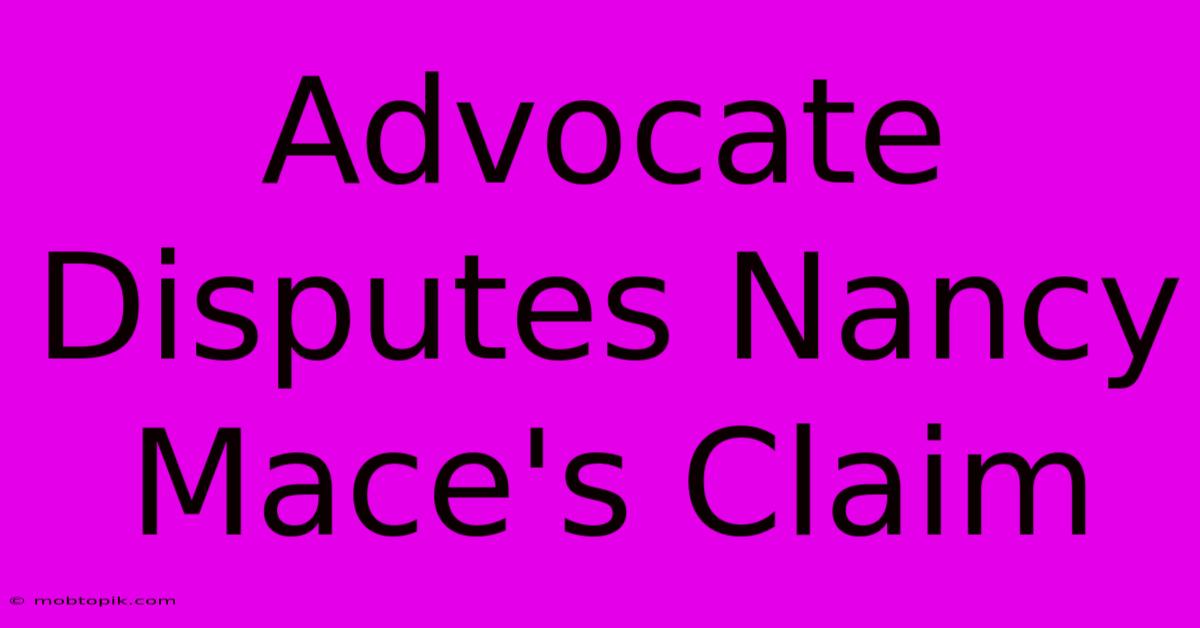Advocate Disputes Nancy Mace's Claim

Discover more detailed and exciting information on our website. Click the link below to start your adventure: Visit Best Website mobtopik.com. Don't miss out!
Table of Contents
Advocate Disputes Nancy Mace's Claim: Unpacking the Controversy
Congresswoman Nancy Mace, representing South Carolina's 1st congressional district, recently made a claim that sparked significant controversy and immediate pushback. This article delves into the specifics of Mace's statement, the counterarguments presented by her critics, and the broader implications of the dispute. We'll analyze the factual basis of each side's argument, examining the supporting evidence and highlighting the key disagreements.
The Original Claim: Understanding Mace's Statement
(This section needs to be filled in with the specific claim made by Congresswoman Mace. The exact wording and context are crucial for a fair and accurate analysis. Replace the bracketed information below with the specifics of her statement.)
Congresswoman Mace stated [insert the exact quote or paraphrase of Mace's statement here]. This statement was made on [date] during [context: e.g., a press conference, a televised interview, a social media post]. The claim immediately generated [describe the initial reaction: e.g., widespread criticism, significant media attention, political debate].
The Counterarguments: Dissecting the Opposition's Views
Several individuals and organizations have publicly disputed Mace's claim. The core of their disagreement generally centers on [summarize the main points of contention]. These counterarguments often highlight [list specific points of disagreement with evidence].
Argument 1: [Specific Counterargument]
[Provide a detailed explanation of the first counterargument. Include specific examples, data, or quotes from the sources disputing Mace's claim. Consider citing reputable news sources, academic papers, government reports, or other authoritative sources to support the accuracy and credibility of the counterargument].
For example, [Advocate's Name], [Advocate's Title], argued that [quote or paraphrase the advocate's statement]. This directly contradicts Mace's assertion that [reiterate Mace's relevant claim]. The evidence presented by [Advocate's Name], including [specific evidence], strongly suggests [conclusion supporting the counterargument].
Argument 2: [Specific Counterargument]
[Provide a detailed explanation of the second counterargument. Again, use specific examples, data, or quotes from reputable sources to support the analysis. Demonstrate a balanced perspective, acknowledging any potential weaknesses or counterarguments to the counterarguments themselves].
Another key point of contention involves [explain the second area of disagreement]. [Source A] points out that [quote or paraphrase the relevant information from Source A]. This challenges Mace's claim by [explain how this evidence refutes or weakens Mace's claim]. Further supporting this viewpoint, [Source B] offers [explain the relevant information from Source B] which adds another layer to the complexity of the issue.
Argument 3: [Specific Counterargument] – and Beyond
[Continue adding more detailed counterarguments as needed. Each counterargument should be thoroughly explained with supporting evidence. Consider including counter-counterarguments to address potential rebuttals from Mace's supporters].
The dispute extends beyond the specific factual claims. The debate also involves [mention any underlying ideological or political disagreements contributing to the controversy]. This adds another layer of complexity, highlighting the broader context surrounding the dispute and the various motivations driving the different perspectives.
Analyzing the Evidence: Weighing the Facts
To understand the validity of Mace's claim and the counterarguments, we must critically analyze the evidence presented by both sides. This requires considering the sources, their credibility, and the potential biases involved.
[This section should provide a detailed comparison of the evidence, examining its strengths and weaknesses. Avoid making definitive conclusions if the evidence is inconclusive. Present the different perspectives fairly and objectively].
For example, Mace's claim relies heavily on [identify the source or type of evidence Mace used]. The credibility of this source can be questioned because [explain potential biases or weaknesses of Mace's evidence]. In contrast, the counterarguments cite [identify the sources used by the opponents]. These sources are generally considered more reliable because [explain why these sources are considered more reliable].
The Broader Implications: Context and Consequences
The controversy surrounding Mace's claim has [describe the wider implications of the dispute, such as political fallout, impact on public opinion, potential legislative consequences, or effect on future policy]. This illustrates the importance of accurate and verifiable information in public discourse and the potential consequences of making unsubstantiated claims.
The debate also highlights [discuss any broader issues raised by the controversy, such as the role of social media in spreading misinformation, the importance of fact-checking, or the challenges of navigating complex political debates]. Understanding these broader issues is crucial for fostering informed public discourse and promoting responsible communication in the political arena.
Conclusion: A Call for Critical Engagement
The dispute over Congresswoman Mace's claim serves as a reminder of the importance of critical thinking and the need for verifiable information in public discourse. While this article has presented different perspectives and analyzed the available evidence, forming a definitive conclusion requires further investigation and consideration of additional information.
The ongoing debate underscores the necessity for responsible fact-checking, careful analysis of sources, and a commitment to informed civic engagement. Only through a rigorous examination of the facts and a willingness to engage in thoughtful discussion can we navigate the complexities of political controversies and arrive at informed judgments. Further research and ongoing dialogue are crucial to fully understanding the nuances of this complex issue.

Thank you for visiting our website wich cover about Advocate Disputes Nancy Mace's Claim. We hope the information provided has been useful to you. Feel free to contact us if you have any questions or need further assistance. See you next time and dont miss to bookmark.
Also read the following articles
| Article Title | Date |
|---|---|
| Ucl Real Madrid Wins Thriller Against Atalanta | Dec 12, 2024 |
| Meta Whats App Instagram Facebook Threads | Dec 12, 2024 |
| Champions League Barcelona Beat Opponent | Dec 12, 2024 |
| Foster Care Advocate Vs Rep Mace | Dec 12, 2024 |
| Cl Barcelona Triumphiert In Dortmund | Dec 12, 2024 |
